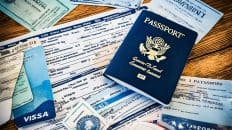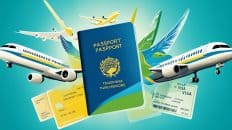Fiance Visa Guide: Easy Steps to Apply
Are you ready to bring your foreign fiancé to the United States to get married? Applying for a Fiance Visa may seem like a daunting task, but with the right guidance and knowledge, it can be a smooth and successful process. From understanding the requirements to navigating the application process, this comprehensive guide will provide you with easy steps to follow.
Applying for a Fiance Visa involves several important stages, including filing the necessary forms, attending a visa interview, and gathering the required documents. With proper preparation and attention to detail, you can make sure that nothing stands in the way of your dream wedding and a future together in the United States.
So, are you ready to take the first step towards your happily ever after? Let's dive into the Fiance Visa process and discover everything you need to know.
Key Takeaways:
- Applying for a Fiance Visa allows a U.S. citizen's foreign fiancé to enter the United States to get married.
- The process involves filing Form I-129F and Form DS-160, attending a visa interview, and paying the necessary fees.
- It's important to ensure eligibility and gather the required documents before beginning the application process.
- The processing time for a Fiance Visa is typically 12-15 months.
- After getting married in the U.S., the foreign fiancé can apply for a marriage green card.
Confirming Eligibility for a K-1 Fiancé Visa
To embark on the journey of obtaining a K-1 fiancé visa, it is crucial to ensure that both the U.S. citizen and the foreign fiancé meet the necessary eligibility criteria. Here are the key requirements for a successful application:
- Fiance Visa Eligibility: Both the U.S. citizen and foreign fiancé must meet the eligibility criteria set by the United States Citizenship and Immigration Services (USCIS). This includes being legally able to marry in the United States.
- Marriage Within 90 Days: The couple must have the intention to marry within 90 days of the foreign fiancé's entry into the U.S. This timeframe is crucial for complying with the terms of the K-1 visa.
- Legal Ability to Marry: It is essential for both parties to meet the legal requirements for marriage in their respective countries. This ensures that the marriage will be legally recognized.
- In-Person Meeting Requirement: The U.S. citizen and foreign fiancé must have met in person at least once within the past two years. However, exceptions can be made for cases involving religious or cultural practices or extreme hardship situations.
- Relationship Legitimacy: USCIS requires evidence or documentation to establish the legitimacy of the relationship between the U.S. citizen and the foreign fiancé. This may include photographs, flight records, letters, texts, emails, or any other form of communication that demonstrates a genuine and committed relationship.
- Income Requirement: The U.S. citizen sponsor must meet the income requirement as determined by the federal poverty guidelines. If the sponsor's income falls below the threshold, they may be required to file a supplemental form or provide additional financial evidence.
"Meeting the eligibility criteria is crucial for a successful K-1 fiancé visa application. Ensuring that you comply with the legal requirements and providing sufficient evidence of your relationship will greatly enhance your chances of obtaining the visa."
It is important to remember that each case is unique, and it is advisable to consult with an experienced immigration attorney to assess your specific circumstances and guide you through the application process.
| Requirement | Description |
|---|---|
| Fiance Visa Eligibility | Both the U.S. citizen and foreign fiancé must meet the eligibility criteria set by USCIS. |
| Marriage Within 90 Days | The couple must have the intention to marry within 90 days of the foreign fiancé's entry into the U.S. |
| Legal Ability to Marry | Both parties must meet the legal requirements for marriage in their respective countries. |
| In-Person Meeting Requirement | The couple must have met in person at least once within the past two years. |
| Relationship Legitimacy | Evidence or documentation must establish the legitimacy of the relationship between the U.S. citizen and foreign fiancé. |
| Income Requirement | The U.S. citizen sponsor's income must meet the federal poverty guidelines, unless a supplemental form is filed. |
Filing Form I-129F
When it comes to obtaining a K-1 visa, it is the responsibility of the U.S. citizen fiancé to file Form I-129F, which serves as the official petition for the visa. This form plays a crucial role in providing evidence of the legitimacy of the relationship between the U.S. citizen and the foreign fiancé.
In order to ensure a successful filing, it is important to gather all the required supporting documents. These include proof of citizenship for the U.S. citizen, proof of the relationship between the couple, and proof of any previous marriages ending, if applicable. These documents are essential in establishing the validity and sincerity of the relationship.
| Supporting Documents |
|---|
| Proof of citizenship for the U.S. citizen |
| Proof of relationship |
| Proof of previous marriages ending (if applicable) |
Along with the necessary documents, there is a filing fee of $535 that must be paid. This fee covers the processing of the petition and can be submitted in the form of a check, money order, or even by credit card.
Once the Form I-129F and supporting documents are compiled and the filing fee has been paid, the petition can be submitted to the appropriate USCIS office for review and processing.
"Filing Form I-129F is a crucial step in the K-1 visa application process. Ensuring the proper completion of the form and inclusion of all necessary supporting documents is essential for a successful petition."
Form I-129F Processing Time

Once you have filed Form I-129F for your fiancé visa, the next step is to patiently wait for the processing time. It's important to note that the processing time for Form I-129F can vary depending on the USCIS service center where it is sent. This means that the time it takes for your petition to be processed may be different from others.
On average, the processing time for Form I-129F can range from 4 to 15 months. It's essential to keep in mind that this timeline is an estimate and can be subject to change depending on various factors such as USCIS workload, policy changes, or other external factors.
During the processing period, it is possible that USCIS may request additional evidence to support your case. These requests for evidence (RFEs) are not uncommon and should not necessarily be a cause for concern. It's crucial to respond promptly and thoroughly to any RFEs to avoid delays in the processing of your petition.
Once your Form I-129F is approved, USCIS will send you an approval notice. This notice will be sent to the mailing address you provided in your petition. Note that the approval notice does not grant your fiancé visa; it's simply a confirmation that your petition has been approved.
It's important to be patient during the Form I-129F processing time and to stay informed about any updates or changes. Keeping track of your case status and preparing for the next steps in the visa application process will help ensure a smooth and successful outcome.
Filing Form DS-160
Once the Form I-129F is approved, the case is transferred to the U.S. Department of State's National Visa Center (NVC). The NVC then notifies the U.S. embassy or consulate in the foreign fiancé's home country, which will schedule a visa interview. In preparation for the interview, the fiancé must complete Form DS-160, the online nonimmigrant visa application.
The Form DS-160 is a comprehensive application that collects personal information, travel plans, and a photograph. It is crucial to provide accurate and truthful information to avoid any delays or complications in the visa processing. After completing and submitting the form, the applicant will receive a confirmation page that must be printed and brought to the visa interview.
| Form DS-160 | Things to Remember |
|---|---|
| Online Nonimmigrant Visa Application |
- Complete all sections accurately and truthfully. - Keep a copy of the confirmation page. - Prepare the necessary supporting documents for the visa interview. |
The Form DS-160 allows the U.S. embassy or consulate to gather essential information about the foreign fiancé, ensuring the visa interview can proceed smoothly. It is important to remember that the DS-160 should be completed carefully, as any mistakes or inconsistencies can lead to delays or even visa denial.
During the visa interview, the consular officer will review the DS-160 information and ask additional questions to assess the eligibility of the fiancé for the K-1 visa. Being well-prepared and having all the required documents in order will greatly increase the chances of a successful interview and visa approval.
Next, we will discuss the essential supporting documents needed for the visa application process.
Supporting Documents for the Visa Application
When applying for a visa, various supporting documents are essential to validate your relationship, personal history, and eligibility. These documents serve as crucial evidence for immigration authorities to evaluate your application. Here is a comprehensive list of the supporting documents typically required:
1. Proof of Relationship:
- Photographs: Include pictures of you and your fiancé(e) together, preferably capturing significant events or moments.
- Flight Records: Provide evidence of any trips taken together, demonstrating your commitment and shared experiences.
- Letters/Texts/Emails: Submit heartfelt correspondence to showcase the genuine nature of your relationship.
2. Birth Certificate:
Each applicant must provide a certified copy of their birth certificate to establish their identity and nationality.
3. Divorce or Death Certificate:
If any previous marriages were terminated through divorce or the death of a spouse, the relevant documentation must be submitted to demonstrate the current eligibility for marriage.
4. Police Clearances:
If you have resided in any country for more than six months, you may be required to obtain a police clearance certificate as proof of good conduct and adherence to the law.
5. Medical Examination:
A medical examination may be necessary to assess the health and admissibility of the visa applicant. This examination typically includes a physical check-up, vaccination verification, and screening for any communicable diseases.
| Supporting Document | Description |
|---|---|
| Proof of Relationship | Showcasing the authenticity of the relationship through photographs, flight records, and correspondence. |
| Birth Certificate | A certified copy of the birth certificate to establish identity and nationality. |
| Divorce or Death Certificate | Documentation confirming the termination of any previous marriages by divorce or the death of a spouse. |
| Police Clearances | Certificates indicating good conduct and compliance with the law, obtained from countries where the applicant resided for more than six months. |
| Medical Examination | An evaluation of the applicant's physical health, vaccination status, and screening for communicable diseases. |
It's crucial to gather all the necessary supporting documents and ensure they are accurate and up-to-date. Adhering to the document requirements will help strengthen your application and increase the likelihood of visa approval.
"A comprehensive and well-prepared set of supporting documents gives immigration authorities the confidence they need to approve your visa application."
Visa Interview and Visa Fee
The visa interview is a crucial step in the K-1 visa application process. It requires the foreign fiancé to attend an interview at the designated U.S. embassy or consulate. This interview is typically straightforward and provides an opportunity for the consular officer to verify the authenticity of the relationship and assess the foreign fiancé's eligibility for the visa.
During the interview, the consular officer may ask questions about the couple's relationship, their plans to marry in the U.S., and their intentions after marriage. It is essential for the foreign fiancé to answer truthfully and confidently, providing any additional documents or evidence if requested. Remember, the consular officer's role is to ensure that the K-1 visa is granted to genuine couples who meet the necessary requirements.
Additionally, the K-1 visa requires the payment of a visa fee. The current fee for a K-1 visa is $265. This fee is typically paid on the day of the visa interview, and payment methods may vary depending on the embassy or consulate. It is important to confirm the accepted payment methods in advance and ensure that sufficient funds are available.
The consular officer will make a decision regarding the visa application on the same day of the interview. In some cases, the consular officer may request additional information or documents before making a final decision. If approved, the foreign fiancé will receive the K-1 visa and can proceed with the next steps of the immigration process.
Entering the United States and Getting Married
Once the K-1 visa is approved, the foreign fiancé will receive a sealed visa packet. It is crucial not to open this packet, as it will be requested by the U.S. Customs and Border Protection at the border.
The foreign fiancé must enter the U.S. within four months of visa issuance. It's important to plan the travel accordingly and ensure all necessary arrangements are made within the given timeframe.
After entering the United States, the foreign fiancé must get married to their U.S. citizen partner within 90 days. This timeframe is a requirement for the K-1 visa, and failing to do so may result in immigration consequences.
Once married, the foreign fiancé can change their status from K-1 to a marriage green card. However, keep in mind that this option is only available for marrying a U.S. citizen. Marrying someone other than the sponsoring U.S. citizen would require a different immigration process.
To initiate the process of changing status, the foreign fiancé must file Form I-485, Application to Register Permanent Residence or Adjust Status. This will allow them to begin the process of becoming a lawful permanent resident in the United States.
It's crucial to understand and comply with all the legal requirements and timelines associated with entering the United States and getting married on a K-1 visa.
"The adventure of moving to a new country and starting a life with your U.S. citizen partner awaits. Take the necessary steps to ensure a seamless transition and the beginning of a beautiful journey together."
Make sure to keep the sealed visa packet safe and ready for presentation at the U.S. Customs and Border Protection. Your journey awaits – step foot in the United States, make memories, and embark on a lifetime of love and happiness with your U.S. citizen spouse.
Applying for a Marriage Green Card
Once you've gotten married, the next step is to apply for a marriage green card, which will grant your foreign spouse permanent residence in the United States. This can be done by filing Form I-485: Application to Register Permanent Residence or Adjust Status.
When applying for a marriage green card, you'll need to submit various forms and documents to support your application. These include:
- Form I-485: Application to Register Permanent Residence or Adjust Status
- I-129F package
- Birth certificate
- Passport
- Police clearances
- Medical examination
The Form I-485 serves as the main application for adjusting status to that of a permanent resident. It is important to fill out the form accurately and provide all required information and supporting documents to avoid any delays or complications in the process.
It's recommended to consult with an immigration lawyer or seek professional guidance to ensure that your application is complete and meets all the requirements. Proper documentation and attention to detail can significantly increase the chances of a successful application.
Marrying a U.S. citizen on a K-1 visa can expedite the process of obtaining a marriage green card. The transition from a K-1 visa to a marriage green card is generally faster compared to other paths to permanent residency.
By following the necessary steps and submitting the required forms and documents, you and your spouse can navigate through the application process with confidence and look forward to building your lives together in the United States.
Eligibility for Same-sex Spouses
Same-sex spouses of U.S. citizens and lawful permanent residents now have the same immigration benefits as opposite-sex spouses. This is a significant step towards equality and inclusivity in immigration policies.
Same-sex spouses can apply for immigrant visas upon approval of the I-130 or I-140 petition. These petitions establish the relationship between the U.S. citizen or lawful permanent resident and their same-sex spouse. Once the petition is approved, the same-sex spouse can proceed with the visa application process.
Additionally, same-sex spouses can also be eligible for K visas, including the K-1 visa for fiancé(e)s. This opens up opportunities for same-sex couples to reunite or start a life together in the United States.
It's important for same-sex spouses to understand their rights and entitlements under the law. Seeking guidance from an experienced immigration attorney can help navigate the process and ensure a smooth application.
Immigration Benefits for Same-sex Spouses:
| Benefits | Description |
|---|---|
| Equal Treatment | Same-sex spouses are entitled to the same immigration benefits as opposite-sex spouses. |
| Immigrant Visas | Upon approval of the I-130 or I-140 petition, same-sex spouses can apply for immigrant visas. |
| K Visas | Same-sex spouses may also be eligible for K visas, including the K-1 visa for fiancé(e)s. |
Note: Same-sex spouses must meet all the eligibility criteria and provide the necessary supporting documentation to obtain these immigration benefits.

K-1 Visa Overview
The K-1 visa is a nonimmigrant visa that allows a foreign-citizen fiancé(e) of a U.S. citizen to enter the United States with the intention of getting married. This visa is specifically designed for couples who plan to marry within 90 days of the fiancé(e) entering the U.S.
Once the couple is married, the foreign-citizen spouse can then apply for adjustment of status to become a permanent resident. The K-1 visa provides an opportunity for couples to start their life together in the United States.
Filing the Petition for a K-1 Visa
When pursuing a K-1 visa, the first step for the U.S. citizen sponsor is to file Form I-129F, the petition for a K-1 visa. This form is submitted to the appropriate USCIS office and plays a crucial role in establishing the relationship between the U.S. citizen and their foreign-citizen fiancé(e).
Form I-129F serves as an official request to the USCIS, outlining the intention to bring the fiancé(e) to the United States for marriage purposes. It is essential to accurately complete the form, providing all required information and supporting documentation to avoid delays or denials.
Additionally, compliance with the International Marriage Broker Regulation Act (IMBRA) requirements is necessary during the Form I-129F filing process. IMBRA aims to protect both the U.S. citizen petitioner and the foreign fiancé(e) by ensuring transparency and providing information about the petitioner's criminal background and previous violations.
IMBRA Requirements
| IMBRA Requirements | Description |
|---|---|
| Disclosure of Certain Criminal Convictions | The U.S. citizen sponsor must disclose any convictions related to domestic violence, sexual assault, child abuse, or stalking, regardless of when they occurred. |
| Foreign Fiancé(e) Rights Brochure | The U.S. citizen sponsor must provide their foreign fiancé(e) with the IMBRA-brochure, which outlines their legal rights and resources available to them in the United States. |
| Non-Disclosure Exceptions | Certain convictions need not be disclosed if they were later annulled, vacated, or expunged, or if the U.S. citizen petitioner establishes that they were not at fault for the conviction. |
Complying with the IMBRA requirements is crucial for the successful processing of the K-1 visa petition. They promote transparency, protect vulnerable individuals, and ensure that all parties involved are well-informed about their rights and resources.
By filing Form I-129F accurately and meeting the IMBRA requirements, the U.S. citizen sponsor takes the first step towards bringing their foreign-citizen fiancé(e) to the United States. This petition establishes the foundation of their relationship and paves the way for further steps in the K-1 visa application process.
Applying for a K-1 Visa at the Embassy/Consulate
Once USCIS approves the petition, it is transferred to the National Visa Center (NVC) for further processing. The NVC then forwards the case to the U.S. embassy or consulate in the foreign-citizen fiancé(e)'s home country. This is where the final steps of the K-1 visa application process take place.
The foreign-citizen fiancé(e) will need to complete Form DS-160, the online nonimmigrant visa application, providing accurate and detailed information about their background, travel history, and purpose of the visit to the United States. This application is vital and serves as the basis for the visa interview.
Next, a visa interview will be scheduled at the U.S. embassy or consulate. The fiancé(e) must attend the interview in person, where a consular officer will evaluate their eligibility for the K-1 visa. The officer may ask questions regarding the relationship, the intent to marry within 90 days of arrival in the U.S., and other relevant aspects of the application. It is essential to be prepared and honest during the interview process.
Medical Examination
Prior to the visa interview, the foreign-citizen fiancé(e) will be required to undergo a medical examination conducted by an authorized physician. The examination aims to ensure that the fiancé(e) does not have any contagious diseases or health conditions that may affect their entry into the United States. The physician will conduct various tests, including a physical examination, blood tests, and vaccinations based on U.S. requirements.
It is crucial to follow the instructions provided by the embassy or consulate regarding the medical examination. Missing or incomplete medical records could delay the visa approval process.

Once the visa interview and medical examination are complete, the consular officer will make a decision on the K-1 visa application. If approved, the foreign-citizen fiancé(e) will receive the visa and additional instructions on how to travel to the United States. It is important to note that the K-1 visa is valid for a single entry, and the foreign-citizen fiancé(e) must enter the United States within six months of visa issuance.
Applying for a K-1 visa at the embassy or consulate is a critical step in the process of bringing the foreign-citizen fiancé(e) to the United States. By completing Form DS-160, attending the visa interview, and undergoing a medical examination, couples can move forward in their journey to unite and begin their life together in the United States.
Rights and Protections
As applicants navigate the process of obtaining a fiancé visa, it is vital for them to be aware of the rights and protections available to them in the United States. The U.S. government is committed to ensuring the safety and well-being of all individuals, and there are resources and support systems in place to address various forms of abuse and violence.
To educate and empower applicants, a comprehensive rights and protections pamphlet is provided. This pamphlet covers essential information about domestic violence, sexual assault, and child abuse, highlighting the resources and services available for those who may be affected.
"Your safety is our priority. We are here to provide you with the support and protection you deserve."
The pamphlet aims to educate applicants about their protection from domestic violence and the available legal remedies. Information regarding obtaining restraining orders, seeking shelter, and accessing support networks is included to ensure that individuals facing domestic violence can find the necessary help during their stay in the United States.
Additionally, the pamphlet highlights the importance of addressing sexual assault and provides guidance on how to report incidents, access healthcare services, and seek counseling and advocacy. By raising awareness and providing resources, the aim is to empower individuals and create a safe environment for all.
The prevention and response to child abuse is also a significant focus of the pamphlet. It outlines the steps individuals can take if they suspect or witness child abuse, including reporting to the appropriate authorities and accessing support services for the child and affected family members.
Support is just a call away
It is encouraging to know that there are organizations and hotlines available across the country dedicated to assisting individuals in need. These hotlines are staffed by trained professionals who can provide guidance, support, and access to essential services.
| Hotline | Focus Area | Contact Number |
|---|---|---|
| National Domestic Violence Hotline | Domestic Violence | 1-800-799-SAFE (7233) |
| National Sexual Assault Hotline | Sexual Assault | 1-800-656-HOPE (4673) |
| Childhelp National Child Abuse Hotline | Child Abuse | 1-800-4-A-CHILD (422-4453) |
No one deserves to live in fear or be subjected to abuse. It is crucial for all applicants to be aware of their rights and the resources available to them, ensuring their safety and well-being. The rights and protections pamphlet serves as a valuable tool in educating and supporting individuals throughout their journey.
Conclusion
Applying for and obtaining a Fiance Visa can be a complex process, but with the help of this comprehensive Fiance Visa guide, you can navigate through it smoothly and successfully. It is crucial to gather all the required documents, ensure eligibility, and attend the necessary interviews to maximize your chances of approval.
Throughout the Fiance Visa application journey, it is important to stay organized and proactive. Pay close attention to the specific requirements outlined by the United States Citizenship and Immigration Services (USCIS) and the U.S. Department of State to avoid any delays or complications.
Once the Fiance Visa is granted, you and your partner can look forward to embarking on your new life together in the United States. From the excitement of the wedding planning to building a future as a married couple, this visa paves the way for incredible possibilities.
FAQ
What is a Fiance Visa?
A Fiance Visa, also known as a K-1 visa, is a nonimmigrant visa that allows a foreign-citizen fiance(e) of a U.S. citizen to enter the United States for the purpose of getting married.
What are the requirements for a Fiance Visa?
To be eligible for a Fiance Visa, both the U.S. citizen and the foreign fiance must meet certain criteria, including being legally able to marry, planning to marry within 90 days of entering the U.S., and having met in person at least once in the past two years.
How do I file for a Fiance Visa?
The U.S. citizen sponsor is responsible for filing Form I-129F, the petition for a Fiance Visa, with the appropriate USCIS office. This form serves as evidence of the legitimacy of the relationship and requires supporting documents.
How long does it take to process Form I-129F?
The processing time for Form I-129F can vary, but it typically takes anywhere from 4-15 months for USCIS to process the petition. Additional evidence may be requested during this time.
What documents are required for the visa application?
Various supporting documents are required for the visa application, including proof of relationship, birth certificates, divorce or death certificates if applicable, police clearances, and a medical examination.
What happens during the visa interview?
The foreign fiance is required to attend the visa interview at the designated U.S. embassy or consulate. The consular officer will make a decision on the same day or may request additional information. The visa fee for a K-1 visa is typically paid at the interview.
What happens after the K-1 visa is approved?
Once the K-1 visa is approved, the foreign fiance will receive a sealed visa packet, which should not be opened. The foreign fiance must enter the U.S. within four months and get married within 90 days. Changing status from a K-1 visa is only possible to a marriage green card and can only be used to marry the sponsoring U.S. citizen.
How do I apply for a marriage green card?
After getting married, the foreign spouse can apply for a marriage green card by filing Form I-485, which requires submitting the necessary supporting forms and documents. Transitioning from a K-1 visa can expedite the process.
Are same-sex spouses eligible for a Fiance Visa?
Yes, same-sex spouses of U.S. citizens and lawful permanent residents are eligible for the same immigration benefits as opposite-sex spouses and can apply for Fiance Visas and marriage green cards.
What is the purpose of a Fiance Visa?
A Fiance Visa allows the foreign-citizen fiance(e) of a U.S. citizen to travel to the U.S. and get married within 90 days. Once married, they can apply for adjustment of status to become a permanent resident.
How can I ensure a successful Fiance Visa application?
To ensure a successful Fiance Visa application, it is important to gather all required documents, meet the eligibility criteria, and attend the necessary interviews. Following a step-by-step guide can help navigate the complex application process.











